Introduction
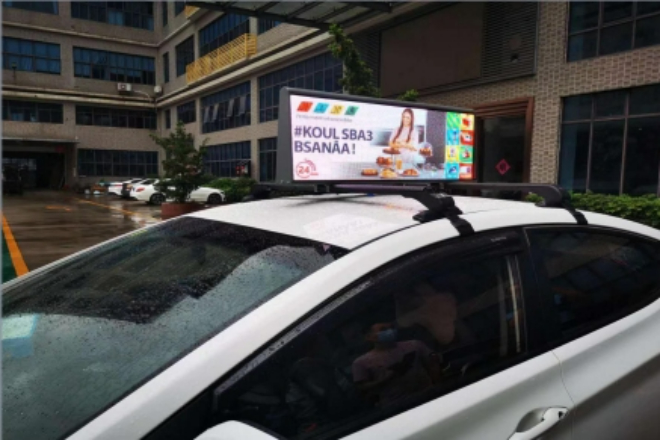
Avec le développement continu de la technologie, l’installation d’écrans LED sur les voitures particulières est devenue une tendance émergente.
Afficheurs LED Ils peuvent non seulement offrir aux automobilistes un espace d'affichage personnalisé, mais aussi remplir diverses fonctions, comme la publicité et les rappels lors d'occasions spécifiques. Cependant, y a-t-il des points importants à prendre en compte lors de l'installation d'écrans LED sur les voitures particulières ?
Remarque 1 : Conformité aux lois et réglementations relatives à l'installation d'écrans LED
Bien que les réglementations varient d'un pays à l'autre, de nombreux pays disposent de lois et de réglementations similaires pour encadrer l'installation de publicités, de logos et d'écrans LED sur les carrosseries de voitures particulières. Voici quelques points juridiques et réglementaires communs :
- Restrictions sur le contenu publicitaire :
Le contenu publicitaire doit être légal, véridique et exact, et ne doit contenir aucune information fausse, trompeuse ou illégale. Certains pays peuvent également exiger que le contenu publicitaire soit approuvé par les autorités compétentes.
- Emplacement et taille de la publicité :
L'emplacement et la taille des publicités sont généralement strictement limités afin de garantir qu'elles ne bloquent pas la vue du conducteur ni ne gênent la sécurité des autres usagers de la route.
Par exemple, les zones clés de la vision de conduite telles que le pare-brise avant, les vitres latérales et les rétroviseurs peuvent interdire l’installation de publicités ou de logos.
- Exigences de performance en matière de sécurité :
L’installation d’écrans LED doit garantir qu’ils n’ont pas d’impact négatif sur les performances de sécurité du véhicule.
Cela implique de s’assurer que l’écran d’affichage est solidement fixé et ne tombera pas ou ne causera pas de danger pendant la conduite.
- Éclairage et luminosité restrictions:
La luminosité de l'écran d'affichage doit être conforme aux réglementations locales en matière de gestion du trafic et ne doit pas provoquer d'éblouissement la nuit ou dans des environnements à faible luminosité, affectant la vue des autres usagers de la route.
Remarque 2 : Sélection de l'écran d'affichage à LED et emplacement d'installation
1). Sélection du type d'écran d'affichage LED
Pour choisir un écran LED adapté à une installation dans un véhicule particulier, plusieurs facteurs doivent être pris en compte, notamment sa flexibilité, son épaisseur, son poids et sa durabilité. Voici quelques types d'écrans LED adaptés à une installation dans un véhicule particulier :
1.1). Écran LED souple:
Les écrans d'affichage LED flexibles ont une flexibilité extrêmement élevée et peuvent s'adapter à diverses surfaces courbes, ce qui les rend adaptés à une installation dans des parties irrégulières du véhicule.
Léger, a un faible impact sur la charge du véhicule et est facile à installer et à retirer.
1.2). Écran LED ultra-fin :
L'écran d'affichage LED ultra-mince a une très faible épaisseur et n'augmentera guère le volume total du véhicule après l'installation.
Il a de bons effets visuels et un affichage clair, adapté aux propriétaires de voitures qui recherchent la beauté et la praticité.
Lors du choix, vous devez également prendre en compte la résolution, la luminosité, le taux de rafraîchissement et d'autres paramètres de l'écran d'affichage pour vous assurer que l'effet d'affichage répond à vos besoins.
Dans le même temps, des produits de qualité fiable et de marques connues doivent être sélectionnés pour garantir la durée de vie et la sécurité.
2). Considérations relatives à l'emplacement d'installation
Les emplacements d'installation des écrans d'affichage LED des voitures particulières sont principalement les vitres arrière, les toits, etc., et chaque emplacement présente ses avantages et ses inconvénients :
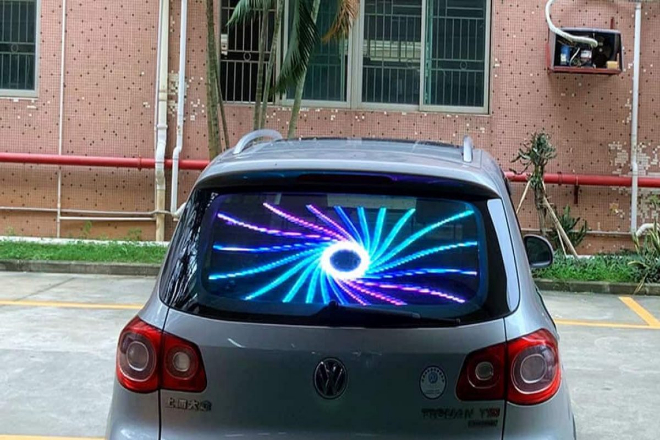
2.1). Installation de la lunette arrière :
Avantages : Installation facile, aucun changement dans l'apparence du véhicule et peu d'impact sur la ligne de conduite.
Désavantages: Cela peut bloquer la visibilité de la lunette arrière et gêner l'utilisation du rétroviseur. Il est donc important de veiller à ce que le contenu de l'écran ne soit pas trop complexe ni trop scintillant afin d'éviter toute gêne pour les autres conducteurs.
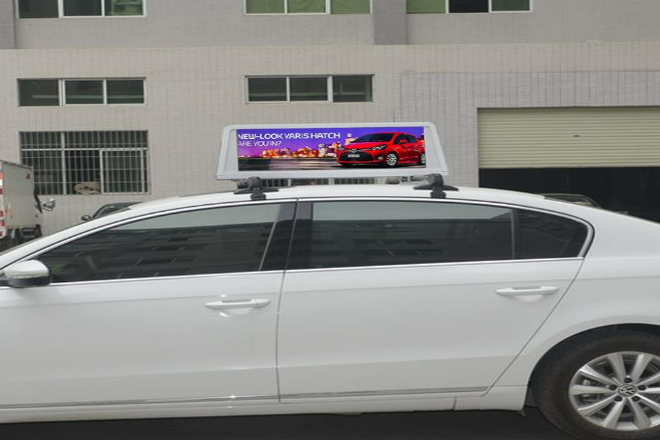
2.2). Installation du toit :
Avantages : Large champ de vision, l'écran d'affichage est facile à voir par les autres véhicules et convient à la publicité ou à la publicité.
Désavantages: Résistance accrue au vent, pouvant affecter la stabilité du véhicule. Il est nécessaire de veiller à une installation solide pour éviter toute chute lors de la conduite à grande vitesse.
Lors du choix de l'emplacement d'installation, des facteurs tels que le blocage de la ligne de visée, la résistance au vent, l'esthétique et la sécurité doivent être pris en compte de manière exhaustive.
Dans le même temps, il est également nécessaire de respecter les lois et réglementations locales pour garantir que le lieu d’installation est légal et conforme.
3). Méthodes et techniques d'installation
Lors de l'installation de l'écran d'affichage LED, les étapes et précautions suivantes doivent être suivies :
3.1). Étapes d'installation :
Déterminez l'emplacement d'installation et assurez-vous que l'emplacement est légal et conforme et n'affecte pas la vision de conduite et la sécurité.
Nettoyez la surface d'installation, retirez la poussière et l'huile et assurez-vous que l'écran d'affichage est fermement collé.
Choisissez une méthode de fixation adaptée au type d'écran d'affichage et à l'emplacement d'installation, par exemple en utilisant de la colle, des vis ou des supports spéciaux.
Connectez le cordon d’alimentation et la ligne de commande pour vous assurer que l’écran d’affichage fonctionne normalement.
Testez l'effet de l'écran d'affichage, ajustez la luminosité et le contenu et assurez-vous que l'effet d'affichage est satisfaisant.
3.2). Méthode de fixation :
Pour les écrans flexibles, une colle spéciale ou du ruban adhésif double face peuvent être utilisés pour le collage afin de garantir que le collage est plat et ferme.
Pour les écrans ultra-minces, des vis ou des supports spéciaux peuvent être utilisés pour la fixation afin de garantir que l'installation est stable et fiable.
3.3). Précautions :
Pendant le processus d'installation, il convient d'éviter d'endommager la surface et la structure interne de l'écran d'affichage.
Assurez-vous que le cordon d'alimentation et la ligne de commande sont correctement et fermement connectés pour éviter les courts-circuits ou les mauvais contacts.
Une fois l'installation terminée, une inspection complète doit être effectuée pour garantir que l'écran d'affichage fonctionne correctement et est fermement installé.
Remarque 3 : Alimentation électrique et sécurité des lignes pour l'installation d'écrans d'affichage à LED
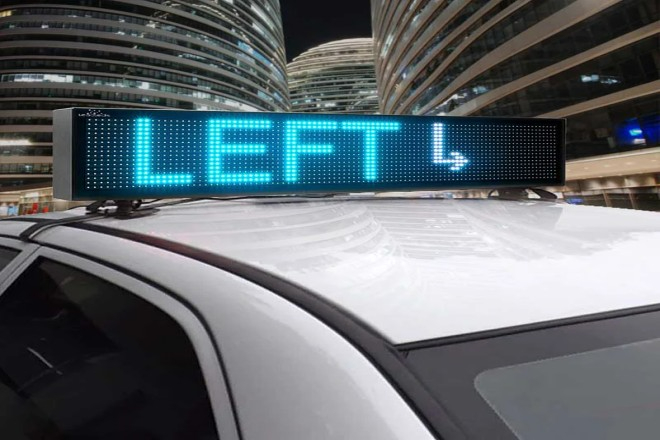
1). Source de courant sélection:
Lors de l'installation d'écrans LED pour voitures particulières, l'alimentation électrique est un enjeu majeur. Un choix judicieux garantit un fonctionnement stable de l'écran ; un mauvais choix peut entraîner des risques électriques, ou du moins des frais de réparation importants.
1.1). Alimentation allume-cigare :
Nos voitures sont équipées d'allume-cigares. Vous pouvez alimenter l'écran en branchant un adaptateur, ce qui est très pratique.
Il est toutefois essentiel de choisir un adaptateur avec protection contre les surcharges. Sinon, si l'écran est légèrement plus chargé ou en cas de problème de ligne, le courant augmentera et risque de griller le circuit de votre véhicule.
Il faut également faire attention à la limite de puissance de l'allume-cigare afin de ne pas laisser votre écran d'affichage devenir un « tigre électrique » et entraîner l'allume-cigare vers le bas.
1.2). Alimentation par batterie :
La batterie, c'est-à-dire la « grosse batterie » de la voiture, dispose d'une puissance suffisante et d'une alimentation électrique stable.
Cependant, il faut être prudent lors du raccordement direct à la batterie et posséder des connaissances professionnelles. Sinon, si les mauvais fils sont connectés ou si le fusible est mal installé, un court-circuit ou un incendie peuvent se produire.
Un fusible ou un disjoncteur doit être installé, tout comme un fusible est installé dans un circuit. En cas de problème, il peut couper l'alimentation électrique à temps pour protéger votre voiture.
Lors du choix d'une alimentation électrique, pensez à la sécurité. Choisissez un modèle fiable, de qualité et conforme aux normes. Il est également conseillé de consulter le manuel du véhicule pour connaître les recommandations et restrictions du fabricant concernant l'alimentation.
2). Disposition des lignes :
La disposition des lignes semble simple, mais il existe en fait de nombreuses astuces.
2.1). Éviter les interférences :
Le saviez-vous ? Les lignes peuvent également entrer en conflit les unes avec les autres, surtout si elles sont trop proches des lignes du système électronique d'origine du véhicule, ce qui peut générer des interférences électromagnétiques et perturber le fonctionnement normal du véhicule.
Les lignes doivent donc être maintenues aussi loin que possible des systèmes électroniques sensibles, tels que les unités de contrôle du moteur, les systèmes d'airbag, etc. Si vous ne pouvez vraiment pas l'éviter, utilisez des fils blindés ou des fils torsadés pour réduire le rayonnement électromagnétique et les interférences.
2.2). Solidement fixé :
Le câble ne doit pas être jeté à la légère dans la voiture ; il doit être solidement fixé à la structure du véhicule à l'aide d'un serre-câble ou d'un serre-câble. Sinon, au démarrage, le câble risque de se balancer, de frotter ou d'être court-circuité, ce qui peut être problématique.
Lorsque la ligne traverse un trou ou un espace métallique, vous devez également être prudent et le sceller avec un manchon en caoutchouc ou un produit d'étanchéité pour éviter que le bord métallique ne coupe la ligne.
2.3). Facile à vérifier :
Le tracé des lignes doit être simple et clair, sans pour autant ressembler à un labyrinthe. Sinon, lors de toute vérification ou réparation ultérieure, il vous faudra du temps pour le retrouver.
Il est préférable de marquer la direction et le but de la ligne au point de connexion clé afin que lorsqu'un problème survient, il puisse être rapidement localisé et résolu sans avoir à le déplacer.
3). Traitement imperméable et anti-poussière :
Les voitures particulières sont inévitablement exposées au vent, à la pluie ou aux mauvaises conditions routières. Il est donc essentiel de les protéger efficacement de l'eau et de la poussière.
3.1). Étanchéité de l'écran LED :
Lors du choix d'un écran, privilégiez un modèle offrant une bonne étanchéité, et dont le niveau doit répondre aux exigences de l'environnement d'utilisation du véhicule. Évitez la moindre pluie, et l'écran se mettra en grève.
Les joints entre l'écran et la structure du véhicule doivent également être scellés avec de la colle imperméable ou des bandes d'étanchéité pour empêcher l'humidité de s'infiltrer. Sinon, une fois l'eau pénétrée, l'écran risque d'être « mis au rebut ».
3.2). Étanchéité des circuits :
Le raccordement de la ligne est un « maillon faible » et doit être scellé avec des joints étanches ou du ruban adhésif étanche pour empêcher l'humidité de pénétrer. Dans le cas contraire, une infiltration d'eau et un court-circuit pourraient être dangereux.
Lorsque la ligne traverse la structure extérieure du véhicule, elle doit également être protégée par un manchon étanche ou un boîtier étanche afin que l'eau de pluie ne puisse pas pénétrer.
3.2). Traitement anti-poussière :
Il arrive que de la poussière ou d'autres particules pénètrent dans la voiture. Il est donc nécessaire de nettoyer régulièrement l'écran et la ligne afin d'éviter que l'accumulation de poussière n'affecte la dissipation thermique et les performances.
Vous pouvez également vaporiser un agent anti-poussière ou installer un filet anti-poussière sur l'écran d'affichage et la surface de la ligne afin que la poussière n'y adhère pas facilement.
Enfin, il est important de prêter attention à l'installation de l'alimentation électrique ou des autres lignes de l'écran LED sur le véhicule. L'installation étant électrique, elle présente un risque. Il est préférable de faire appel à un installateur professionnel.
Remarque 4 : Contrôle du contenu et de l'affichage de l'écran LED
1). Spécification du contenu :
L'installation d'écrans LED sur les voitures particulières est un atout pour attirer l'attention. Cependant, le contenu affiché doit être conforme aux règles et ne doit pas être négligent ni enfreindre la loi et la réglementation.
1.1). Légal et conforme :
Tout d'abord, le contenu de l'écran LED doit être légal et ne pas contenir d'informations malveillantes telles que la pornographie, les jeux d'argent, la drogue, la violence, le terrorisme et les rumeurs. Ces contenus sont illégaux.
De plus, ne portez pas atteinte à la vie privée, à la réputation, etc. d’autrui. Par exemple, ne mettez pas négligemment les photos, les noms ou les informations sensibles d’autres personnes sur l’écran d’affichage.
1.2). Civilité et amabilité :
Le contenu affiché à l'écran doit être civilisé et convivial, sans langage vulgaire, insultant ou provocateur. Nous devons posséder des voitures de qualité et ne pas contribuer aux troubles sociaux.
Il est préférable d’afficher du contenu positif, comme des publicités de service public, des slogans d’énergie positive, etc. Cela attirera non seulement l’attention, mais transmettra également une énergie positive, rendant la société plus harmonieuse et plus belle.
1.3). Respecter le code de la route :
N'oubliez pas de vous concentrer sur la conduite et de ne pas vous laisser distraire par le contenu de l'écran LED. Par conséquent, le contenu affiché ne doit pas être trop complexe ni trop clignotant afin de ne pas gêner la vue des autres conducteurs.
En bref, le contenu affiché doit être légal, civilisé et convivial, et le code de la route doit être respecté. C'est la seule façon pour que l'affichage devienne une vitrine d'énergie positive plutôt qu'une source de problèmes.
2). Réglage de la luminosité et des couleurs :
La luminosité et la couleur de l'écran LED sont essentielles. Un réglage correct garantit une excellente qualité d'affichage ; un réglage incorrect peut entraîner des problèmes de clarté.
2.1). Ajustez la luminosité en fonction de la lumière ambiante :
En journée, lorsque la luminosité est forte, il est conseillé d'augmenter la luminosité de l'écran pour une meilleure lisibilité. La nuit ou par temps nuageux, il est conseillé de diminuer la luminosité pour éviter d'éblouir les autres.
Certains écrans avancés disposent également d'une fonction de réglage automatique de la luminosité, qui ajuste automatiquement la luminosité en fonction de la lumière ambiante. C'est pratique, et vous n'avez pas besoin de le régler manuellement.
2.2). Réglage des couleurs :
La couleur doit également être bien ajustée. Une couleur trop vive peut être éblouissante, tandis qu'une couleur trop claire peut être floue. Il est donc essentiel d'adapter la couleur au contenu pour le rendre plus vivant et plus lisible.
Vous pouvez également ajuster la couleur en fonction des occasions ou des fêtes. Par exemple, pendant le Nouvel An chinois, optez pour le rouge, plus festif ; en temps normal, optez pour le bleu ou le vert, plus rafraîchissants.
En bref, il faut s'efforcer d'ajuster la luminosité et les couleurs de l'écran. Il faut les adapter à la lumière ambiante et au contenu pour que l'écran brille dans différents environnements et attire l'attention. Il faut également veiller à ne pas éblouir les autres et être un propriétaire de voiture de qualité.
Remarque 5 : Sécurité de conduite et entretien des véhicules après l'installation d'écrans d'affichage à LED
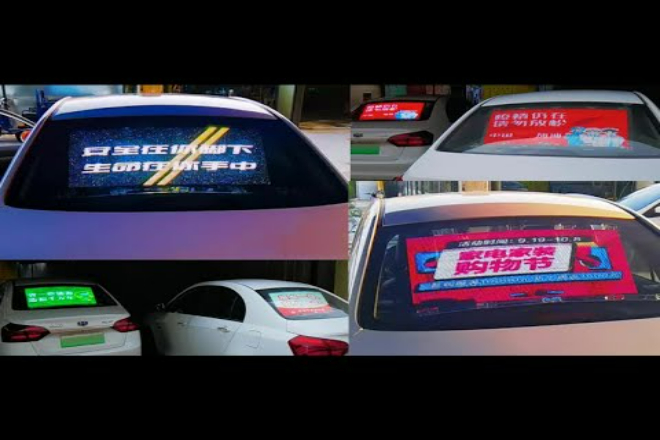
1). Impact sur la sécurité routière :
Bien que l'installation d'écrans LED sur les voitures particulières puisse être très ludique et pratique, elle peut également avoir un impact sur la sécurité routière. Il est donc important de prendre ces problèmes de sécurité potentiels au sérieux.
1.1). Impact sur la visibilité de conduite :
L'emplacement et la taille de l'écran LED doivent être soigneusement choisis afin de ne pas gêner la vue du conducteur. En particulier, pour les écrans installés sur le pare-brise ou les vitres latérales, il faut veiller à ce que leur contenu n'attire pas trop l'attention du conducteur, ce qui pourrait le distraire au volant.
La luminosité et la couleur de l'écran d'affichage doivent également être correctement réglées pour éviter l'éblouissement la nuit ou dans des environnements à faible luminosité, affectant la vue et le jugement du conducteur.
1.2). Impact sur la stabilité du véhicule :
L'installation d'un écran d'affichage peut augmenter la résistance au vent du véhicule, notamment à grande vitesse. Par conséquent, la conception et l'installation de l'écran doivent minimiser son impact sur les performances aérodynamiques du véhicule afin d'en garantir la stabilité.
De plus, le poids et la position d'installation de l'écran d'affichage doivent également être pris en compte pour éviter les effets néfastes sur le système de suspension du véhicule et la stabilité de conduite.
Afin de garantir la sécurité de conduite, nous devons respecter strictement les réglementations et normes en vigueur lors de l'installation d'écrans d'affichage à LED pour garantir que la position, la taille, la luminosité et la couleur de l'écran d'affichage n'auront pas d'impact négatif sur la vision de conduite et la stabilité du véhicule.
2). Gestion des pannes :
Bien que nous ayons effectué une maintenance suffisante, certains défauts courants peuvent encore survenir sur les écrans d'affichage à LED, tels qu'un écran noir, un écran fleuri, etc. Ces défauts affectent non seulement l'effet d'affichage, mais peuvent également avoir un certain impact sur la sécurité de conduite.
2.1). Défaut d'écran noir :
En cas de panne d'écran noir, vérifiez d'abord si la connexion électrique est normale et si le fusible est grillé.
Si la connexion électrique est normale, il peut s'agir d'un défaut de circuit sur l'écran interne ou d'un module de commande endommagé. Dans ce cas, contactez un technicien de maintenance pour une inspection et un remplacement.
2.2). Défaut d'écran floral :
Le défaut de l'écran de fleurs peut être causé par un court-circuit dans le circuit interne de l'écran d'affichage, une transmission de signal instable ou une défaillance du module de commande.
En cas de dysfonctionnement de l'écran de protection, vérifiez d'abord si la ligne de connexion est lâche ou endommagée et si la transmission du signal est stable. Si le problème persiste, contactez un technicien de maintenance pour une inspection et un remplacement.
Lors de la gestion des pannes, la sécurité doit être primordiale et il est conseillé d'éviter toute inspection ou tout remplacement pendant la conduite. En cas d'urgence, le véhicule doit être garé en lieu sûr et dans les délais impartis, et un personnel de maintenance professionnel doit être contacté pour intervention.
En résumé, après l'installation d'un écran LED, il est essentiel d'être attentif à son impact sur la sécurité routière, d'effectuer un entretien régulier et de traiter rapidement les pannes courantes. Cela permet de garantir un affichage optimal et une stabilité optimale, garantissant ainsi une sécurité de conduite optimale.
Conclusion
Grâce à l'élaboration de cet article, nous avons une compréhension détaillée des nombreux aspects auxquels il faut prêter attention lors de l'installation d'écrans LED sur des voitures particulières, notamment le respect des lois et réglementations, la sélection et l'installation de l'écran, l'alimentation électrique et la sécurité des lignes, le contenu et le contrôle de l'affichage, la sécurité de conduite et l'entretien, ainsi que la confidentialité et l'impact social.
Ces précautions ne sont pas seulement liées aux droits et intérêts légitimes des propriétaires de voitures, mais sont également directement liées à la sécurité routière et à l’ordre social.
Enfin, si vous souhaitez en savoir plus sur les écrans LED, veuillez nous contacter.
